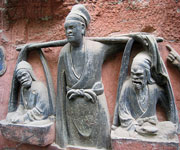Dazu Rock Carvings is located in the steep hillsides of the Dazu area contain an exceptional series of rock carvings dating from the 9th to the 13th century. They are remarkable for their aesthetic quality, their rich diversity of subject matter, both secular and religious, and the light that they shed on everyday life in China during this period. They provide outstanding evidence of the harmonious synthesis of Buddhism, Taoism and Confucianism. The Dazu carvings represent the pinnacle of Chinese rock art for their high aesthetic quality and their diversity of style and subject matter. Tantric Buddhism from China and the Chinese Taoist and Confucian beliefs came together at Dazu to create a highly original and influential manifestation of spiritual harmony.

Continent: Asia
Country: China
Category: Cultural
Criterion: (I) (II)(III)
Date of Inscription: 1999
High Aesthetic Chinese Rock Art
The eclectic nature of religious belief in later imperial China is given material expression in the exceptional artistic heritage of the Dazu rock art. Tantric Buddhism from China and the Chinese Taoist and Confucian beliefs came together at Dazu to create a highly original and influential manifestation of spiritual harmony. The Dazu carvings represent the pinnacle of Chinese rock art for their high aesthetic quality and their diversity of style and subject matter.
 |
| Dazu Rock Carvings China |









No comments:
Post a Comment